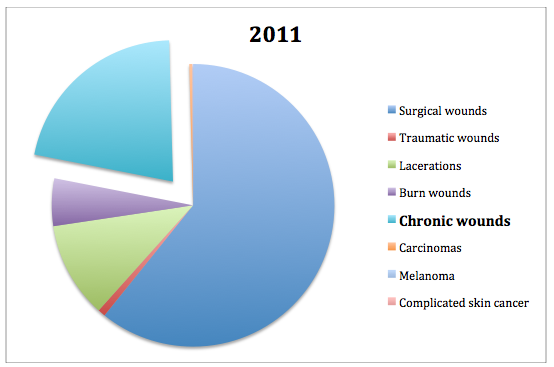Wounds have many different sources, etiologies and forms and, therefore, demand a range of approaches. By virtue of these differences, they have considerably different costs. At the top of the list of wound culprits driving up cost is the category of chronic wounds. Simply put, these wounds are very slow to heal due to poor circulation at the site (e.g., decubitus stasis, or pressure, ulcers), concomitant health issues (diabetes) and the difficulty in changing the local environment toward one with conditions more conducive to the healing process.
Wounds have many different sources, etiologies and forms and, therefore, demand a range of approaches. By virtue of these differences, they have considerably different costs. At the top of the list of wound culprits driving up cost is the category of chronic wounds. Simply put, these wounds are very slow to heal due to poor circulation at the site (e.g., decubitus stasis, or pressure, ulcers), concomitant health issues (diabetes) and the difficulty in changing the local environment toward one with conditions more conducive to the healing process.
Chronic wounds are not the most common — that is a category represented by surgical wounds, in which the wound has been created medically or surgically in order to excise or otherwise manage diseased tissue. But surgical wounds, traumatic wounds and lacerations are by their nature acute and, especially for surgical wounds, can be surgically managed to create clean wound edges, good vascularization and other conditions that accelerate healing. Therefore, while the volume of surgical and traumatic wounds and lacerations is significant, their costs are manageable and their growth is unremarkable.
But the costs of chronic wounds are higher due to both the types of different products required and the length of time required for those products to be used. Moreover, given the association of chronic wounds with conditions that are growing in prevalence due to increasing incidence of obesity, diabetes and other conditions, combined with an aging population that is increasingly sedentary, the prevalence of chronic wounds is shifting the balance among wound types. Below is the balance of wound types by prevalence worldwide in 2011, followed by the projected balance of wound types in 2025.
Worldwide Share of Wound Prevalence By Type, 2011
Source: MedMarket Diligence, LLC; Report #S190 and Report #S249.
Worldwide Share of Wound Prevalence By Type, 2025
Source: MedMarket Diligence, LLC; Report #S190 and Report #S249.
Surgical wounds offer the potential for use of devices which can ensure hemostasis, prevent internal adhesions and anastomoses, secure soft tissue, and close the skin. Traumatic wounds also offer potential for skin closure products and for hemostats, and adhesion prevention during post-trauma surgery. New wound-covering sealant products may also offer potential for treatment of cuts, grazes, and burns.
Chronic wounds are generally not amenable to treatment by adhesives, sealants and hemostats unless the wound has either been debrided to a sterile bleeding surface (in which case it becomes like a surgical wound), or the product offers some stimulant activity. Many hemostats exhibit some inflammatory and cytokinetic activity, which has been associated with accelerated healing. However, this inflammatory activity has also been known to burn the patient’s skin. Chronic wounds are instead dealt with often by a combination of debridement, frequent dressing changes, products to address local vascular circulation and pressure (negative and positive) and others. Progress is being made in reducing the associated healing times, but a large opportunity remains.
